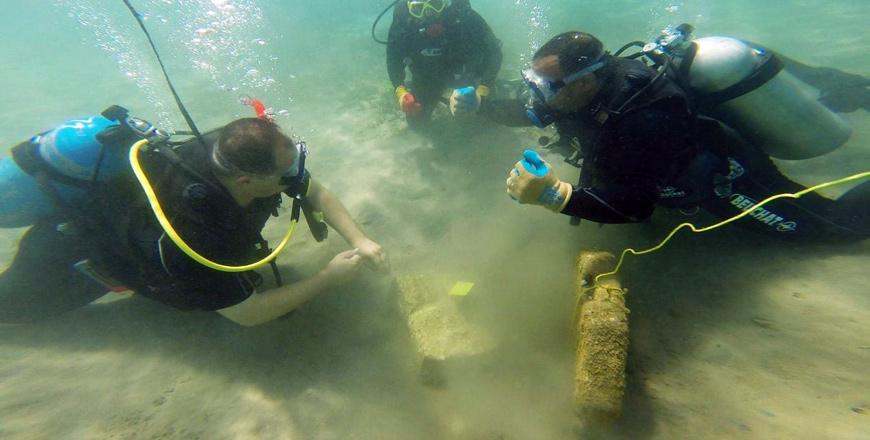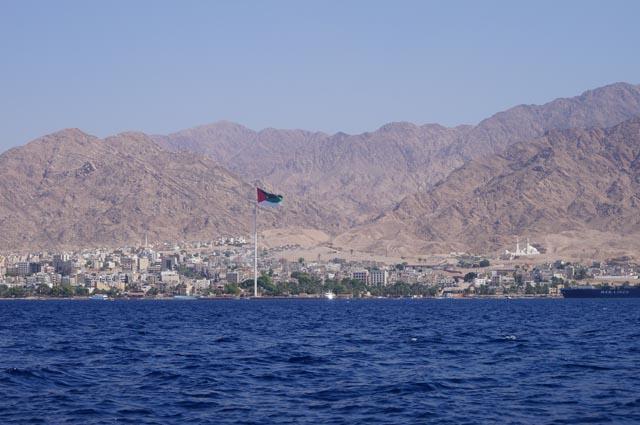You are here
Umayyad-era sunken marine port unearthed in Aqaba Gulf
By Hana Namrouqa - Feb 26,2018 - Last updated at Feb 26,2018

Jordan’s first underwater archaeological expedition traced ruins of the Islamic city of Ayla in the Gulf of Aqaba (Photo courtesy of JREDS)
AMMAN — A sunken marine port structure in the Gulf of Aqaba was unveiled on Monday as findings of Jordan’s first underwater archaeological expedition tracing ruins of the Islamic city of Ayla were announced.
The unearthed port dates back to the Umayyad period towards the end of the Fatimid period (650-1116 AD), according to the findings of the survey, which also unveiled a 50-metre-long and eight-metre-wide barrier.
“The barrier is connected to a solid mud floor which extends outside the coast. The solid mud floor was found to be interspersed with a two-lane corridor which connects the port and the sea gate to the city and its stores. It is suggested that the lane was used for the transport of the port’s imports and exports,” the survey’s results, which were made available to The Jordan Times, read.
The Royal Marine Conservation Society of Jordan (JREDS), which implemented the survey project in partnership with different stakeholders, announced the results during a conference in Aqaba.
JREDS implemented the survey in partnership with the USAID-funded project "Sustainable Cultural Heritage Through Engagement of Local Communities", and in cooperation with the Department of Antiquities.
HRH Princess Basma, president of JREDS, said on Monday at the conference that the society seeks to protect the marine environment while also ensuring sustainable development.
“Understanding our cultural and historical values is a tool to increase our commitment towards Jordan and the conservation of its heritage and values,” a press statement issued by JREDS quoted Princess Basma as saying.
Ehab Eid, JREDS' executive director, said that experts involved in the survey expect that the marine port discovered in the Gulf of Aqaba to include other components to be unveiled, such as a furnace for the production of pottery, and spaces for the maintenance and manufacture of ships and sails among other facilities.
“The stone mortar found at the site is likely to have been produced there. Work is under way to identify the extent of the activity of the port of Ayla, which links the commercial road from the Levant, Hijaz, Egypt and the Maghreb with the maritime navigational route that reaches India, east and south Asia and Africa,” Eid told The Jordan Times.
He noted that the society has deployed local experts to document the history of the Islamic city of Ayla, underlining that it also sought the support of experts from the Egyptian Department of Antiquities, who are specialised in underwater archaeology.
Also on Monday, the society and Jordan’s Department of Antiquities signed a memorandum of understanding to strengthen cooperation in the areas of field research, educational and environmental awareness, protection of archaeological sites and organising events that are consistent with the protection of natural and cultural heritage.
Related Articles
AMMAN — Findings of Jordan’s first underwater archaeological expedition searching for traces of the early Islamic city of Ayla will be made
AMMAN — For the first time ever, archaeologists will carry out an underwater excavation in July in the Gulf of Aqaba, hoping to discover the
The Royal Marine Conservation Society of Jordan (JREDS) concluded a Reef Check Ecodiver training session in Aqaba late last week.



















